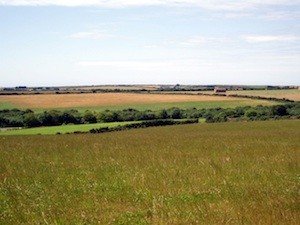November 16, 2012,
Santiago, Chile.
There are only a few people who get it: the era of cheap food is over.
Global net population growth creates over 200,000 new mouths to feed ever single day. Yet supply of available farmland is diminishing each year due to development, loss of topsoil, peak production yields, and reduction in freshwater supply.
Then there’s bonehead government policy decisions to contend with… like converting valuable grains into inefficient biofuel for automobiles. Paying farmers to NOT plant. Banning exports. Etc.
Of course, the most destructive is monetary policy. The unmitigated expansion of the money supply has led to substantial inflation of agriculture commodities prices.
These fundamentals overwhelmingly point to a simple trend: food prices will continue rising. And that’s the best case. The worst case is severe shortages. This is a trend that thinking, creative people ought to be aware of and do something about.
One solution is to buying farmland overseas. It provides an excellent hedge against inflation, plus it’s one of the best (and most private) ways to move money abroad, out of the jurisdiction of your home government.
In a way, overseas farmland is like storing gold abroad. But unlike gold, it produces a yield, ensures that you have a steady food supply, and even provides a place to stay in case you ever need to leave your home country.
So where are the best places to buy?
After travel to over 100 countries, looking at more properties than I can count, and investing in quite a few of them, I’ve come up with a few top picks that meet the following criteria:
– cheap land costs
– low operating costs
– highly productive soil
– low political risk (confiscation, regulation, market interference)
– foreigner-friendly ownership rules
– clear water rights
– climatic stability
Believe it or not, these simple requirements eliminate most of the world. Much of central and Eastern Europe is too politically risky. Western Europe and the US tend to be cost prohibitive. Most of Asia disallows foreign ownership of farmland. Etc.
But there are still several places that remain. I’ll share two of them:
1. Chile. No surprises, Chile ticks all the boxes. Land costs are very reasonable, and operating costs are low. The soil in regions 6, 7, and 8, is some of the most productive on the planet. And best of all, Chile has some of the clearest, most marketable water rights in the world.
Another great thing about Chile is its location; it’s counter-seasonal to the northern hemisphere, so Chilean harvests tend to come at a time of tighter global supplies, pushing up prices.
As an example, we’re currently harvesting blueberries at our farm in Chile’s 7th region. Global blueberry supply is tight in November, so the price we receive is 35% higher than if we were in the northern hemisphere.
See www.chile-farmland.com for more information, it’s a fantastic resource.
2. Georgia. This may be shocking to some, but Georgia is a stable, growing country that’s definitely worth betting on.
Putting boots on the ground there, it’s clear that Georgia is on an upward trajectory with a bright future, much like Singapore was decades ago. Taxes are low, and the country is open to foreigners.
In fact, the government realized that they have tremendously high quality farmland, yet limited expertise in farming. So while most nations shut their doors to foreigners owning strategic farmland, Georgia went abroad actively seeking foreigners to come to their country.
They hit the jackpot in South Africa, offering land, financial incentives, and even citizenship opportunities to South Africans who would move to Georgia and work the land.
Land costs in Georgia are very low; top quality crop land costs about $3,000 per acre, compared to $10,445 in Iowa, or $12,000 in California. Yet simultaneously, yields are very high for everything from corn to wine gapes to peanuts, on par with both of those states.
It’s definitely a contrarian agricultural investment worth considering.








